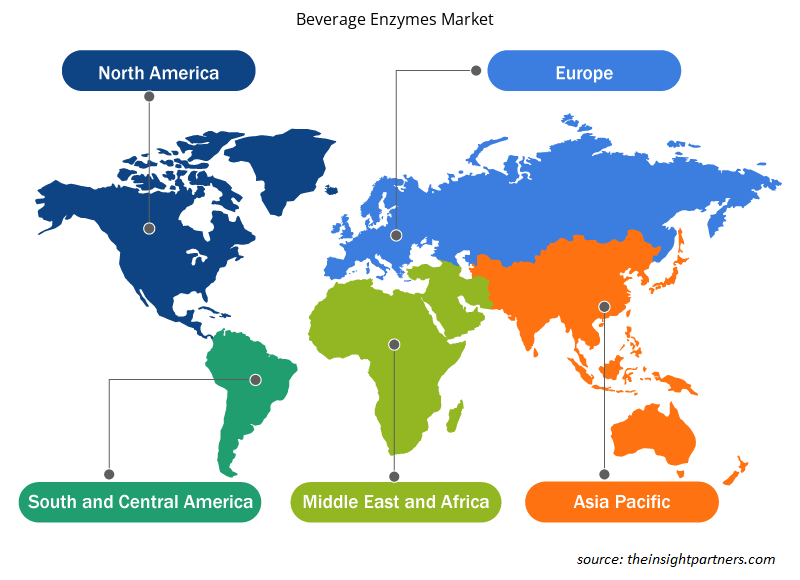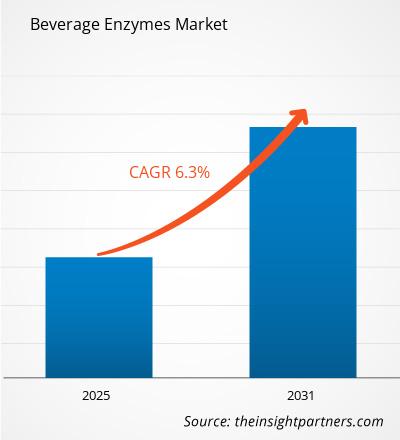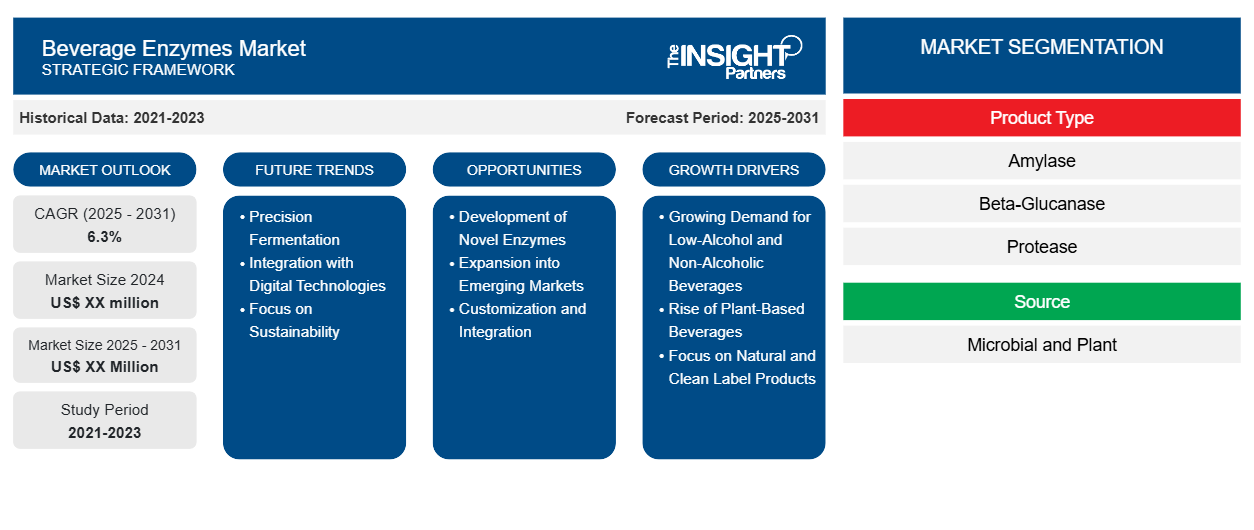预计饮料酶市场在 2023 年至 2031 年期间的复合年增长率为 6.3%,市场规模将从 2023 年的 XX 百万美元扩大到 2031 年的 XX 百万美元。
报告分为三个部分:产品类型(淀粉酶、β-葡聚糖酶、蛋白酶、木聚糖酶)、来源(微生物和植物)和形式(液体和粉末)。全球分析按区域和主要国家细分。上述分部分析的市场评估以美元表示。
报告目的
Insight Partners 发布的《饮料酶市场》报告旨在描述当前形势和未来增长、主要驱动因素、挑战和机遇。这将为各种业务利益相关者提供见解,例如:
- 技术提供商/制造商:了解不断变化的市场动态并了解潜在的增长机会,从而能够做出明智的战略决策。
- 投资者:对市场增长率、市场财务预测以及整个价值链中存在的机会进行全面的趋势分析。
- 监管机构:监管市场政策和警察活动,旨在最大限度地减少滥用行为,维护投资者的信任和信心,维护市场的完整性和稳定性。
饮料酶市场细分
产品类型
- 淀粉酶
- β-葡聚糖酶
- 蛋白酶
- 木聚糖酶
来源
- 微生物与植物
形式
- 液体和粉末
地理
- 北美
- 欧洲
- 亚太
- 南美洲和中美洲
- 中东和非洲
地理
- 北美
- 欧洲
- 亚太
- 南美洲和中美洲
- 中东和非洲
定制此报告以满足您的需求
您可以免费定制任何报告,包括本报告的部分内容、国家级分析、Excel 数据包,以及为初创企业和大学提供优惠和折扣
-
获取此报告的关键市场趋势。这个免费样品将包括数据分析,从市场趋势到估计和预测。
饮料酶市场增长动力
- 低酒精和无酒精饮料需求不断增长:消费者越来越多地选择更健康的饮料,推动了对低酒精和无酒精饮料的需求。酶在这些饮料的生产中发挥着至关重要的作用,可以改善风味、香气和整体质量。
- 植物性饮料的兴起:植物性饮食的日益普及和对乳制品替代品的需求不断增长,推动了植物性饮料市场的增长。酶对于改善杏仁奶、燕麦奶和豆奶等植物性饮料的口感、质地和稳定性至关重要。
- 专注于天然和清洁标签产品:消费者越来越需要经过最少加工的天然和清洁标签产品。酶提供了一种自然有效的方法来提高饮料的质量和加工效率,符合消费者的偏好。
饮料酶市场未来趋势
- 精准发酵:精准发酵技术的进步将使生产出稳定性、特异性和活性更高的新型酶成为可能。这将带来更高效、更可持续的酶生产过程。
- 与数字技术的融合:人工智能 (AI) 和机器学习 (ML) 等数字技术的融合将优化饮料生产中的酶使用。这将有助于制造商提高工艺效率、降低成本并提高产品质量。
- 关注可持续性:对可持续性的日益关注将推动对采用可持续方式生产的环保酶的需求。
饮料酶市场机会
- 新型酶的开发:研发工作专注于开发具有独特功能的新型酶,例如用于改善果汁颜色、风味和保质期的酶以及用于增强植物饮料口感的酶,将带来巨大的增长机会。
- 扩展到新兴市场:新兴市场对加工和包装食品和饮料的需求不断增长,为饮料酶市场带来了巨大的增长机会。
- 定制和集成:定制酶解决方案以满足特定客户要求并将其无缝集成到饮料生产过程中的能力对于市场成功至关重要。
饮料酶市场区域洞察
Insight Partners 的分析师已详尽解释了预测期内影响饮料酶市场的区域趋势和因素。本节还讨论了北美、欧洲、亚太地区、中东和非洲以及南美和中美洲的饮料酶市场细分和地理位置。

- 获取饮料酶市场的区域特定数据
饮料酶市场报告范围
| 报告属性 | 细节 |
|---|---|
| 2023 年的市场规模 | XX 百万美元 |
| 2031 年市场规模 | XX 百万美元 |
| 全球复合年增长率(2023 - 2031) | 6.3% |
| 史料 | 2021-2022 |
| 预测期 | 2024-2031 |
| 涵盖的领域 |
按产品类型
|
| 覆盖地区和国家 |
北美
|
| 市场领导者和主要公司简介 |
|
饮料酶市场参与者密度:了解其对业务动态的影响
饮料酶市场正在快速增长,这得益于终端用户需求的不断增长,而这些需求又源于消费者偏好的不断变化、技术进步以及对产品优势的认识不断提高。随着需求的增加,企业正在扩大其产品范围,进行创新以满足消费者的需求,并利用新兴趋势,从而进一步推动市场增长。
市场参与者密度是指在特定市场或行业内运营的企业或公司的分布情况。它表明在给定市场空间中,相对于其规模或总市场价值,有多少竞争对手(市场参与者)存在。
在饮料酶市场运营的主要公司有:
- 英国联合食品公司
- 诺维信
- 帝斯曼
- 巴斯夫
- 克里斯·汉森
免责声明:上面列出的公司没有按照任何特定顺序排列。

- 了解饮料酶市场顶级关键参与者概况
主要卖点
- 全面覆盖:报告全面涵盖了饮料酶市场的产品、服务、类型和最终用户的分析,提供了整体概况。
- 专家分析:报告基于对行业专家和分析师的深入了解而编写。
- 最新信息:该报告涵盖了最新信息和数据趋势,确保了其与业务的相关性。
- 定制选项:此报告可以定制以满足特定客户要求并恰当地适应业务策略。
因此,饮料酶市场研究报告有助于引领解读和了解行业情景和增长前景。尽管可能存在一些合理的担忧,但本报告的总体优势往往大于劣势。
- 历史分析(2 年)、基准年、预测(7 年)及复合年增长率
- PEST和SWOT分析
- 市场规模、价值/数量 - 全球、区域、国家
- 行业和竞争格局
- Excel 数据集
近期报告
客户评价
购买理由
- 明智的决策
- 了解市场动态
- 竞争分析
- 客户洞察
- 市场预测
- 风险规避
- 战略规划
- 投资论证
- 识别新兴市场
- 优化营销策略
- 提升运营效率
- 顺应监管趋势























 获取免费样品 - 饮料酶市场
获取免费样品 - 饮料酶市场